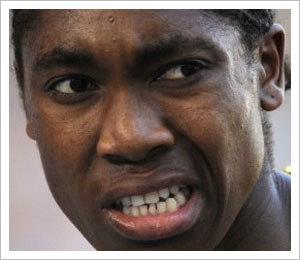Semenya to run 800m final despite gender doubts
 Berlin - South African teenager Caster Semenya was elibible to run in the 800 metres world championship final set for later Wednesday even though the ruling body IAAF doesn't know for sure whether she is a woman.
Berlin - South African teenager Caster Semenya was elibible to run in the 800 metres world championship final set for later Wednesday even though the ruling body IAAF doesn't know for sure whether she is a woman.
Spokesman Nick Davies said the IAAF requested a gender verification process after the 18-year-old burst onto the scene this year and ran a world leading 1 minute 56.73 three weeks ago.
Doubts were raised because of her masculine physique and Davies said a complex process of medical examinations has started, with results expected within the next weeks.
"We don't have any conclusive evidence that she should not be allowed to run," Davies told reporters.
"We are waiting for the report ... We simply ran out of time," said Davies, adding it would be nonetheless "terribly wrong to withdraw the athlete."
South African athletics officials were quoted as saying that they had no reason to suspect that she was a man or was born with male and female chromosomes.
IAAF Council member Helmut Digel told the German Press Agency dpa that the federation has to tread carefully.
"We have to take the aspect of discrimination into account ... We must follow the rules and protect the athlete," Digel said.
Digel added that the IAAF is aware of the problem and that Semenya is not the only suspicious case.
Last year some runners reportedly voiced similar concerns towards Kenyan Pamela Jelimo, who also came out of nowhere as a teenager, won 800m Olympic gold and ran the third best time in event history. Davies said that Jelimo did not undergo a gender test.
"Suspicion has been raised at youth and junior championships that manipulations in this area have been encouraged by certain state authorities, espcially in developing countries," Digel said.
Gender testing was introduced at the Olympics in 1968 after several eastern Bloc athletes had raised suspicion. By now the gender verification only takes place in suspicious cases, with the IOC mainly concerned about athletes who seek an advantage through a gender change.
Women normally have two X chromosomes; men an X and a Y chromosome which means that only athletes with two X chromosomes are eligible for women's events. However, experts say that this test does not cover the so-called intersex condition.
Stella Walsh of Poland won 100m silver in Berlin at the 1936 Olympics. After her death in 1980 in the US an autopsy revealed that she had male genitals and both male and female chromosomes, a condition known as mosaicism.
Indian 800m runner Santhi Soundarajan was stripped of her silver medal at the 2006 Asian Games after failing a gender test. She has lived her life as a woman and reports suggested she may have the Androgen insensitivity syndrome: physical characteristics of a woman but a male chromosome in the genetic make-up.
Davies said that even if Semenya is found out not to be a woman she could not simply be stripped of a gold if she succeeded on Wednesday.
"It is no straightforward procedure, it is legally complex. If she always thought she was a woman it would be no cheating," Davies said. (dpa)